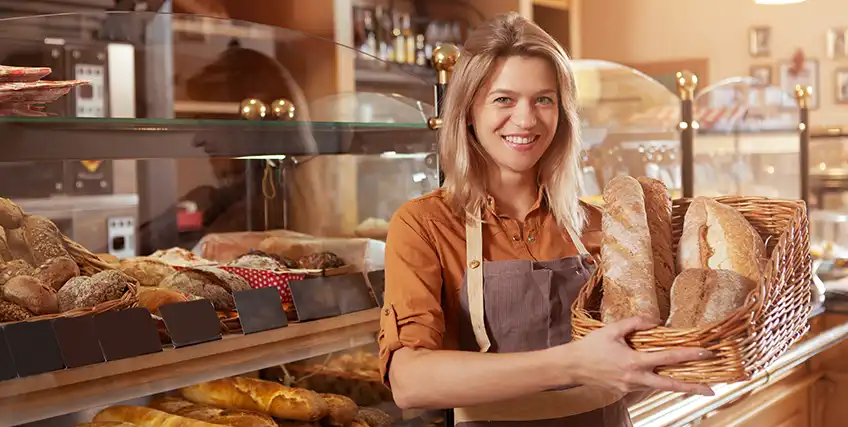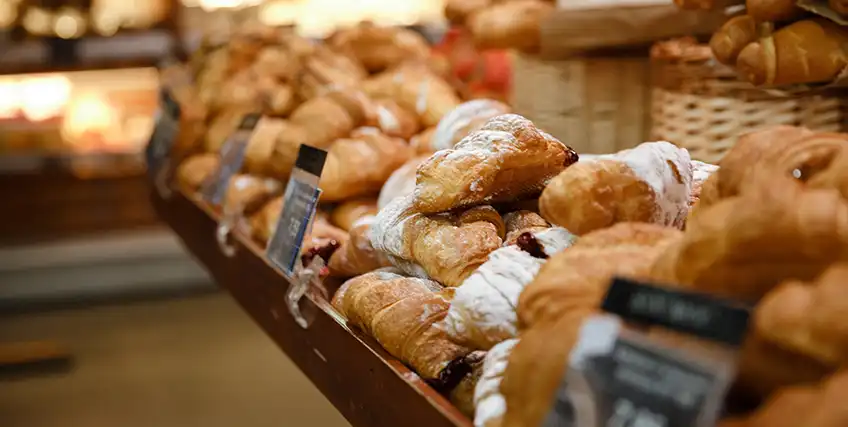Baking a Better Future: How Bakery Loans Can Fund Equipment Upgrades
March 31, 2025 | Last Updated on: April 02, 2025

Running a bakery is a dream job for many culinary-minded entrepreneurs but for bakery owners, it’s about more than baking up delicious confectionaries. Bakeries have many operating costs, but one of the most significant is equipment.
From commercial ovens and mixers to refrigeration units and more, bakery equipment is essential to smooth operations. When something breaks down, it can put a serious dent in your cash flow. Fortunately, there are bakery equipment financing options that can support new equipment purchases, maintenance, and upgrades that can keep your business running smoothly.
In this article:
- How small business loans can serve as bakery equipment financing.
- Why baking equipment is so essential to bakery operations and freeing up working capital for other needs.
- The benefits of buying vs. bakery equipment leasing.
What is Bakery Equipment Financing?
Every bakery needs equipment, but commercial kitchen equipment tends to be very expensive. You still have overhead costs, staffing costs, ingredients to buy, and many more expenses. Financing allows you to buy or lease bakery equipment with a reduced upfront cost instead of paying for it over time. (You might even consider short-term rental bakery equipment in some cases.)
Traditional lenders like banks and credit unions, online lenders, and even some manufacturers may offer bakery equipment financing.
Why Do Bakeries Need Financing?
Loans can help virtually any business manage funds and meet goals. Some of the key benefits of financing solutions for bakeries include:
- Expansion: Bakery business loans can help cover costs to open new storefronts and reach new customers. Whether it’s renovating your existing space to offer more seating for customers or opening new locations, a bakery loan supports expansion while freeing up working capital.
- Managing seasonal inventory: Many bakeries offer specials throughout the year, from pumpkin-flavored items in the fall to gingerbread around Christmas, and more. These changing demands are more manageable with financing solutions.
- Marketing and branding: Building a loyal customer base is crucial for any bakery in a competitive landscape. A bakery business loan can fund advertisements, community events, or hiring a professional marketing company to support your branding and website development.
- Equipment upgrades: Bakery loans are crucial for bakery equipment financing. Bakers need commercial convection ovens, sheeters, mixers, and more expensive restaurant equipment. By financing equipment, you can reduce the strain on available capital while ensuring your business has the best tools possible.
What Are the Benefits of Bakery Equipment Financing?
Bakery equipment financing offers several benefits to small business owners:
- Reduced upfront costs: Although financing may cost more in the long run due to the interest rate, you can typically buy or lease equipment with just a down payment rather than the full upfront cost.
- Flexibility: Between buying or leasing, lenders may offer flexible repayment plans that help you better budget and manage your cash flow each month.
- Newer equipment: When you finance, you may be able to afford higher-quality, more expensive equipment to keep your bakery on the cutting edge.
Bakery Equipment Financing Options
The two primary bakery equipment financing options are getting a business loan or an equipment lease. However, within either category there are specific options that may make sense depending on your situation. These include:
- Equipment loans: Many lenders offer secured equipment loans that use the equipment itself as collateral to secure the loan.
- Term loans: Term loans are conventional loans in which a lender provides a borrower an upfront lump sum payment in exchange for repayment over a negotiated term. These loans generally have few restrictions on how you use the money, so they’re useful for buying equipment while also supporting other business needs.
- Business lines of credit: A line of credit is a cross between a loan and a business credit card. You’re approved for a maximum loan amount, but you only pay interest when you withdraw from the credit line. This gives you flexibility to cover equipment purchases and other business expenses as needed. As long as you repay a revolving line of credit, you’ll have access to the full loan amount.
- Merchant cash advances: MCAs are commercial agreements between borrowers and MCA providers that operate almost like a loan. The provider pays you a cash advance in exchange for a percentage of future credit card and debit card sales. As your sales increase, you pay more, up to a total amount determined by a factor rate. These usually do not require additional collateral and have few restrictions on how you use the money.
- Business credit cards: Like personal credit cards, business credit cards allow you to make purchases now and pay them back later. They usually have a much faster application process than loans, so if you need to make equipment purchases fast and feel comfortable about paying them off quickly, credit cards can be good options.
- Finance lease: A finance lease gives you the option to buy equipment at the end of the contract. Either you can pay a residual sum to keep the equipment, extend the lease, or return the equipment to the lessor.
- Operating lease: This simple long-term rental agreement does not have the option to buy the equipment at contract end. You make a down payment, pay a monthly lease payment, and the lessors provide equipment maintenance and servicing during the lease period.
Buying vs. Leasing Bakery Equipment
When it comes to bakery equipment financing, there are benefits to both buying and leasing.
When you buy equipment, you’ll borrow a sum of money from a lender to make the purchase and repay the amount over time plus interest and fees. Usually, the equipment itself is used as collateral to secure the loan, which means the lender may seize it if you fail to repay. At the end of the contract, you’ll own the equipment outright.
Commercial bakery equipment for lease may give you a bit more flexibility. Rather than buying the bakery equipment, you’re essentially taking out a long-term rental. During the lease term, you’ll make payments to a lender or retailer, and at the end of the lease, you’ll usually have the option to buy the equipment outright or return it to the retailer.
In either case, you’ll typically make monthly payments, although leasing often requires lower payments because you’re not paying for the whole value of the equipment.
Generally, you should consider bakery equipment loans if:
- You have additional business finance needs beyond equipment.
- You don’t want to change equipment every few years.
- You can get wholesale or volume purchase discounts from a dealer.
- You want to own the equipment after the contract.
Generally, you should consider bakery equipment leasing if:
- You want lower monthly payments.
- You don’t want to be responsible for maintenance costs.
- You want new equipment every few years.
Final Thoughts
Like any business, bakeries often need financing solutions to support operations. Whether you’re starting a brand new bakery or you’ve been in business for a while, bakery equipment financing can be a vital lifeline to give you the commercial equipment you need to make baked goods at scale. There are benefits to both buying and leasing, so the right option depends on whether or not you want to own the equipment outright at the end of the term.
FAQs about bakery equipment financing
How much does commercial bakery equipment cost?
Bakery equipment costs vary significantly depending on your bakery’s needs. Toast estimates that initial bakery equipment costs may range anywhere from $3,000 to $20,000.
What equipment does a bakery need?
Your bakery’s equipment needs may vary depending on what kind of baking goods you serve, but generally, you’ll need mixers, ovens, bakeware, sheet pan racks, refrigerators, freezers, a fryer for doughnuts, and a dough proofer.
How can I finance bakery equipment?
There are many bakery equipment financing options. You can purchase it with an equipment loan, term loan, or more flexible solutions like a business credit card or line of credit. You can also get commercial bakery equipment for lease through a lender or retailer.
How can bakeries use financing?
Bakery loans can support your business in many ways, including supporting inventory and staffing needs, covering overhead costs, upgrading equipment, and much more.
Should I buy or lease bakery equipment?
Ultimately, it depends on your personal preferences. You should lease bakery equipment if you want a lower monthly payment, fewer maintenance costs, and don’t mind upgrading every few years. If you want more stable ownership of equipment for a longer period of time, you should consider buying.




